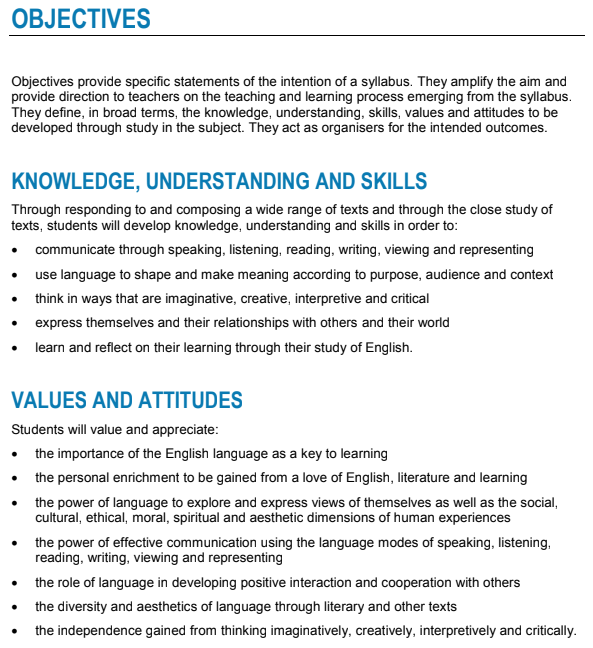A key factor that is often overlooked in the teaching of reading (such as the L3 / Reading Recovery / Phonics / Decodable readers debates) are the objectives of the K-10 English syllabus:

Of specific interest to me as a prospective teacher librarian, and indeed, all who attempting to grasp the content outcomes of literacy, are the concepts of
- ‘Students will value and appreciate the importance of the English language as a key to learning‘
- ‘Communicating through speaking, listening, reading, writing, viewing and representing’
- ‘The personal enrichment to be gained from a love of English, literature and learning’ and
- ‘The independence gained from thinking imaginatively, creatively, interpretively and critically.’
As educators, we can get caught up in the content / outcomes / assessments / learning progressions / teaching students ‘how’ to do things like read and write, that we forget the ‘why’ objective(s) of teaching English in the first place: to unlock the door of learning, enabling enrichment of life through independent thought and communication.

While reading Barone (2011), I was impressed by the determination of reading being more than just learning how to decode and learning how to comprehend – something that has been a bugbear of mine over the years while attempting to implement first, the Accelerated Literacy pedagogy, followed by the L3 (reading & writing) pedagogy in my stage 1 EAfS NSW Far West classrooms, the NSW Learning Continuums, followed by the ACARA Learning Progressions, as well as the recent push for teaching synthetic phonics and using decodable readers – leading to the question of whether the school library collection should be ‘levelled’ based on ability. (Learning to read / Reading to learn is something I discussed in a previous blog post). We must engage our students with texts and enable them to become lifelong readers! We must not just focus on the ‘how’ to read, but also the ‘why.’
 So often, we explain ‘why’ or ‘what’ we are learning when it comes to writing or math outcomes…why do we not explain the purpose for reading lessons?
So often, we explain ‘why’ or ‘what’ we are learning when it comes to writing or math outcomes…why do we not explain the purpose for reading lessons?
Barone (2011) explains the ‘why’ we read, something we should be clarifying in our ‘W.e A.re L.earning T.o’ lesson introductions, in greater detail: “Reading to learn to read: Young children and adults alike engage in reading in order to learn to read. Teachers, parents, or tutors carefully select books that are just right for independent reading or a bit challenging for reading supported by a competent reader. Reading for pleasure: Adults and children read just for the joy of entering an imaginative world. Or they read just for the pleasure and satisfaction of learning something. Reading to enjoy vicarious experiences: Some books allow readers to discover what it was like to participate in a historical event, live in a different environment, or survive hardships. Readers are able to take on the persona of a character to better understand an event beyond their personal realm. Reading to develop background knowledge. Frequently, readers pursue topics that inform them about the world and important events. It is not possible for adults and children to experience everything directly; books offer these opportunities. Reading to understand: Adults and children often read biographies and historical fiction to understand an event or person. Others read to better understand an aspect of science or a scientist and the motivation behind a discovery. Reading to understand who we are: By exploring how characters solve dilemmas, readers can reflect how they might respond to similar circumstances and thus come to know themselves better. Reading to ponder: Adults and children read to explore ideas and beliefs—for instance, the beliefs of a culture or community—to compare them with their own. Reading to appreciate: Adults and children read to appreciate the quality of a book or the art within. They reread a favourite phrase or explore an illustration for the pleasure they derive from it. Reading to engage in conversation: Reading opens opportunities for adults and children to exchange ideas. They argue about a character and why he or she did something. They disagree about whether they both liked the same book or author. Importantly, this exchange allows readers to enjoy and appreciate a book more fully. (and) Reading to solve problems: Books can help readers solve a current problem they are facing” (Barone, 2011, p. 4-5).
References
Barone, D. M. (2011). Children’s literature in the classroom: Engaging lifelong readers. Retrieved from Proquest Ebook Central.
NSW Education Standards Authority (NESA). (2012). K-10 NSW English Aim and Objectives. [Screen Shot]. Retrieved from https://educationstandards.nsw.edu.au/wps/portal/nesa/k-10/learning-areas/english-year-10/english-k-10/aim-and-objectives
